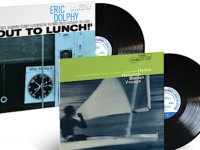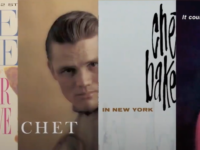The Blue Note record label has been commemorating its landmark 80th birthday this year with a host of events and releases of music, video and more. Of special note have been various album reissues, particularly the Tone Poet Audiophile Vinyl Reissue Series.
Every few months throughout the year, the label has put out one or two recordings from its vast archive. A recent batch included celebrated recordings from guitarist Kenny Burrell, saxophonist Dexter Gordon and pianist Andrew Hill.
What all of these albums have in common is that they were originally produced by Blue Note co-founder/owner Alfred Lion. They were engineered and recorded by Rudy Van Gelder, at his Van Gelder Studios in Hackensack or Englewood Cliffs, New Jersey; the art work was done by Reid K. Miles and the photographs were by Blue Note co-founder/owner Francis Wolff. Joe Harley of Music Matters supervised the reissues and the key to these Tone Poet releases is the mastering by Kevin Gray of Cohearent Audio.
Only original analogue master tapes were used to remaster all the releases in the series. In the boom that has gone on for some years for high-quality, vinyl album remastering, Gray is the acknowledged, undisputed master. He is to today’s world of remastering what George Martin and Phil Spector were to record production at another time. Those who closely watch the recent Blue Note jazz reissue program of Music Matters are aware that Gray and Harley also are leading the series.
All of these albums feature the original, iconic Blue Note art work. The new issues also include a gatefold record album package, with rare photos, 180-gram weight, heavy-duty, vinyl albums and vinyl album sleeves and outer poly-bags. Eighteen releases from the series are planned for 2019. Here’s a look at a few key entries:
KENNY BURRELL – INTRODUCING KENNY BURRELL (1956): Kenny Burrell’s debut began a run of three albums recorded for Blue Note before moving to the Prestige label.
Before even finishing college, Burrell played with Dizzy Gillespie and was performing with other yet unknown, future jazz giants such as Pepper Adams, Donald Byrd, Elvin Jones and Yusef Lateef. Like many of the unheralded guitarists of jazz who are often overshadowed by horn players, Burrell was heavily influenced by Charlie Christian.
On Introducing Kenny Burrell, however, his distinguishing melodic, light and cool tone displayed a new modern jazz sound. This particular release has a breezy, inviting sound and, although the album was recorded on the East Coast and Burrell was born in Detroit, it has a West Coast, cool jazz vibe.
Burrell’s sidemen are more collaborators and include Tommy Flanagan on piano, Paul Chambers on bass, Kenny Clarke on drums and Candido on conga and drums. The inclusion of conga gives the album a polyrhythmic, exotic kick, embellished by the extraordinary drums of the highly influential drummer Kenny Clarke. This is one of Clarke’s most well-known, post-bop sidemen outings.
This album, released as it was originally in mono, is a must for fans of jazz guitar and launched the career of an artist still going strong today at 88.
DEXTER GORDON – CLUBHOUSE (1979): Clubhouse is a unique album in the vast discography of Dexter Gordon. Although it originally arrived in 1979, the music dates back to 1965. This wasn’t unusual for Gordon. In fact, there have been roughly 20 other sessions from the ’50s and ’60s that weren’t issued in the same period as they were initially recorded.
Considered part of Gordon’s late bebop period, Clubhouse has a swinging and jaunty, yet understated vibe, with Gordon effortlessly proving why he is one of the all-time jazz legends of the tenor sax. His sidemen include Freddie Hubbard on trumpet, Barry Harris on piano, Bob Cranshaw on bass and Billy Higgins on drums.
Like the Burrell album, the drummer here almost steals the show: Higgins played on many bop recordings and was essentially the Blue Note house drummer for a period of time. He was going for a laid-back vibe, similar to Gordon, and rather than exploring complicated bop workouts, he seemed to be having the time of his life.
ANDREW HILL – BLACK FIRE (1963): Andrew Hill’s Black Fire falls in line with the more complicated and adventurous post-bop modal style. While it was his sophomore release, Black Fire was the first of what would become 13 albums on Blue Note over roughly a six-year period.
He was already drawing on a deep well of experience. The Chicago native toured alongside Miles Davis and Charlie Parker, even as a teenager. He played with the Paul Williams band, backed Dinah Washington and, after moving to New York, backed Johnny Hartman.
Black Fire, released here as it was originally in stereo, features Roy Haynes on drums, Richard Davis on bass and Joe Henderson on tenor sax. Henderson released his debut album and his second album as a leader that year and appeared on 10 albums as a sideman – including the classic Sidewinder from Lee Morgan, Bobby Hutcherson’s debut release and two Grant Green titles.
As adventurous as Black Fire was at the time, Hill would range even further into the avant-garde over his next four albums and continue his modal jazz experiments. This is another defining Blue Note and jazz release – and one serious jazz fans must seek out.
Also worth noting is the Blue Note 80 Vinyl Reissue Series: Launched on May 10, and set to continue on into the spring of 2020, this more price-conscious series boasts 36 planned releases so far. They are broken up into various sub-series: Blue Note Debuts, Blue Grooves, Great Reid Miles Covers, Blue Note Live and Blue Note Drummer Leaders. The series will be curated by label president Don Was and the label’s longtime publicist Cem Kurosman.
Like the Tone Poet Series, the Blue Note 80 reissues will be pressed on 180-gram vinyl and mastered from the original analog tapes by Kevin Gray. There will be no gatefolds, but the albums will be available at a mid-priced level.
[SOMETHING ELSE! INTERVIEW: Dr. Lonnie Smith, the genie of the B-3, joins us to discuss his intriguing career, a surprise comeback and musical intersections with George Benson and Lou Donaldson.]
There are three recent reissues worth checking out from the Blue Grooves sub-series. The first is Think!, a 1968 album from B3 organist Lonnie Smith. His second album, and debut on Blue Note, includes support from the likes of Lee Morgan. Another is 1969’s Blue Mode from organ leader Reuben Wilson. His third album features a fiery cauldron of free jazz, soul jazz, funk and black consciousness.
Finally, check out Blacks and Blues, the third album from flutist Bobbi Humphrey. Released in 1973, it’s a funky and soulful jazz crossover album that broke Humphrey to a larger audience. Blacks and Blues was followed the same year by Bobbi Humphrey Live: Cookin’ with Blue Note at Montreux, which showcased an historic performance from the Swiss jazz festival.



